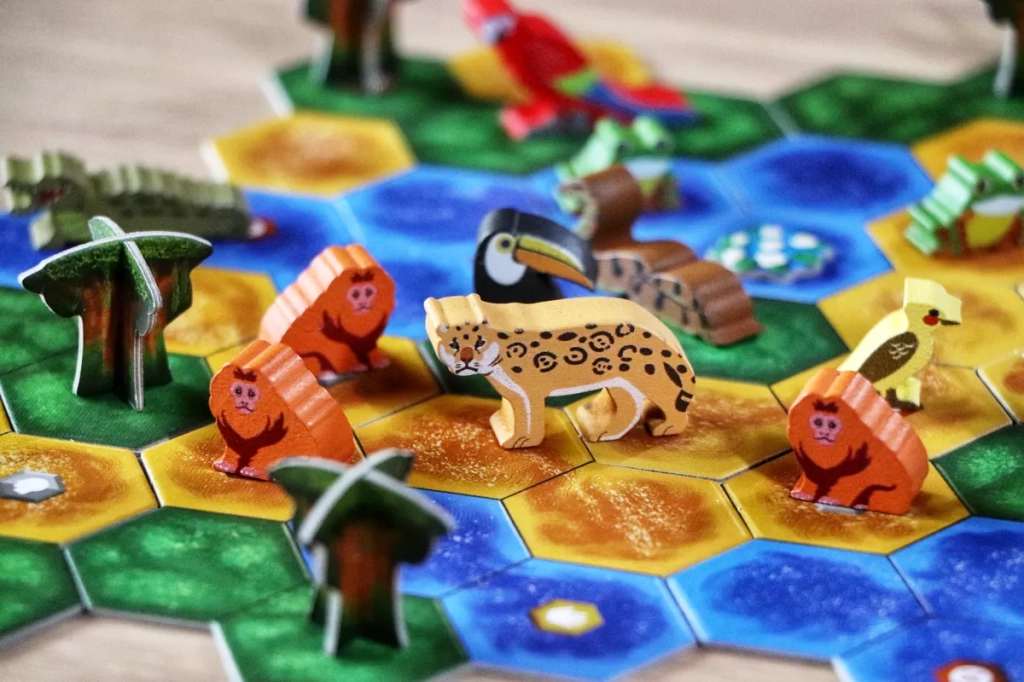Life of the Amazonia – Impressions After One Play
Last night, my father-in-law, my wife and a friend sat down at the table to play Life of the Amazonia, the latest game successfully Kickstarted by Bad Comet Games. “’Life of the Amazonia’ is a medium-weight strategic meeple placing game that combines bag building and pattern building.
In Life of the Amazonia, you’ll be invited to the lush jungle of the Amazon to join in the mission of building an ecologically rich jungle. The beautiful animals of the Amazon will guide you through the deep puzzles and strategic experience. After a pleasantly challenging game, you’ll find that there is a beautiful jungle created in front of each player.”
Please note that this article is not a How to Play for Life of the Amazonia
Getting Life of the Amazonia to the table
What I really like about Life of the Amazonia is the token bin included in the box. While there is a bit a assembly to get it setup, once you do, almost all the tokens you will use during the game are nicely sorted and stored in those boxes. To get the game going, simply take that out of the box and remove the lids. Everything else, however, takes a bit of work.
You need to decide which set of animals you’re going to use (A, B, C, D, or F) and set those cards out on the table, adding the required number of those animals near the cards. You also need to shuffle and lay out three cards from each of the insect and scenery nature cards. Build and setup the Waterfall of Life, and place the player markers on each track. Then each player needs a discard boat, a bag, the required starting chips, and a unique animal to the start the game.
For our first time playing, it took about 10 minutes to setup the table.
Going through the rules of Life of the Amazonia
There are a ton of rules for Life of the Amazonia, but almost everything is adequately described on the included player aid cards. In fact, I read the rulebook ahead of game night, and simply used the reference guide to teach the others how to play. It worked out well, and while there were a few things we looked in the rulebook to clarify, 90% of the game was played simply using the reference cards.
Teaching the game took us about 20 to 25 minutes total, including questions from players and a few things clarified in the rulebook.
How Life of the Amazonia plays
This game is definitely a mixture of Cascadia and bag building to purchase what you need. We found as first time players that the hardest aspect for all of us is deciding when to build your bag, and deciding when to use resources to improve your tableau.
There is a very delicate balance between expanding your terrain, buying trees and lilies, getting animals, and improving your bag. One of us definitely spent to much time building their bag, which meant they rarely pulled what they really needed, and lost by quite a margin. I spent to much time culling my bag – removing tokens that I didn’t deem necessary – and while it made my food game really strong, I struggled in other areas and ultimately also lost by a wide margin.
My father-in-law and my wife finished the game only 5 points apart, and neither of them could really pinpoint what their strategy was. By comparing my tableau to theirs, I could tell they diversified a bit more than I did. My father-in-law went after an animal late-game that got him 5 points per animal he played of that type, while also buying end-game scoring cards. My wife diversified even more, but focused all the animals she did purchase around the lilies she got often. Both of them got far on all the tracks, racking up points I never did.
What we found odd about the entire experience was my wife thought she was doing so poorly throughout the entire game, while I was feeling overly confident in my game. In the end, none of that mattered as she won and I finished 3 by 16 points.
I think Life of the Amazonia can be a game where you might feel helpless. If you don’t pull the tiles you need from the bag, you might feel like you are making no progress. What we realized, however, is that you shouldn’t compare your tableau and how full it is to what others are doing. The player who scored 4th had the most objects in their tableau, and myself who had the second most items in my tableau finished 3rd. You quickly realize this game is all about how you plan, and how you use your resources.
I focused so hard on getting the giant otter, for example, that I held onto resources turn-to-turn. My wife, on the other hand, always made a good and wise purchase if she had the resources to do it, regardless of something she was “hoping” to get. Is that a better strategy? Perhaps.
Final Thoughts
The one thing we all said when finishing the game is how we really wanted to play it again. The entire game, with setup and teaching, took us about 2.5 hours. The game box suggests 60-150 minutes, so it definitely falls within that time frame. I think the game flows really well, and if players pre-plan their turns while others are playing, it could probably move a lot faster than what we experienced. For me, I cannot wait to play this again, and again, and again. Look out for a more detailed review in the near future!

